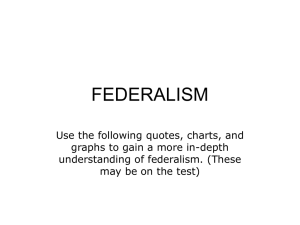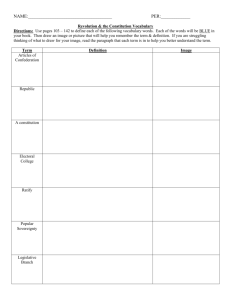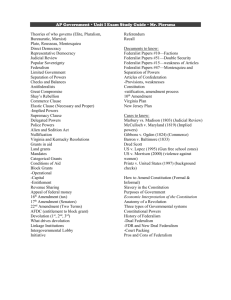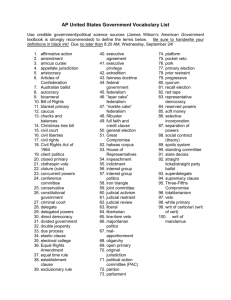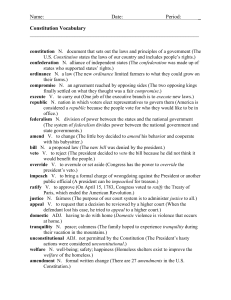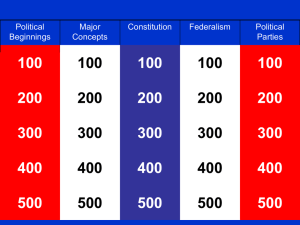In-classgrouppresentations/GovernmentInstitutions/2015
advertisement
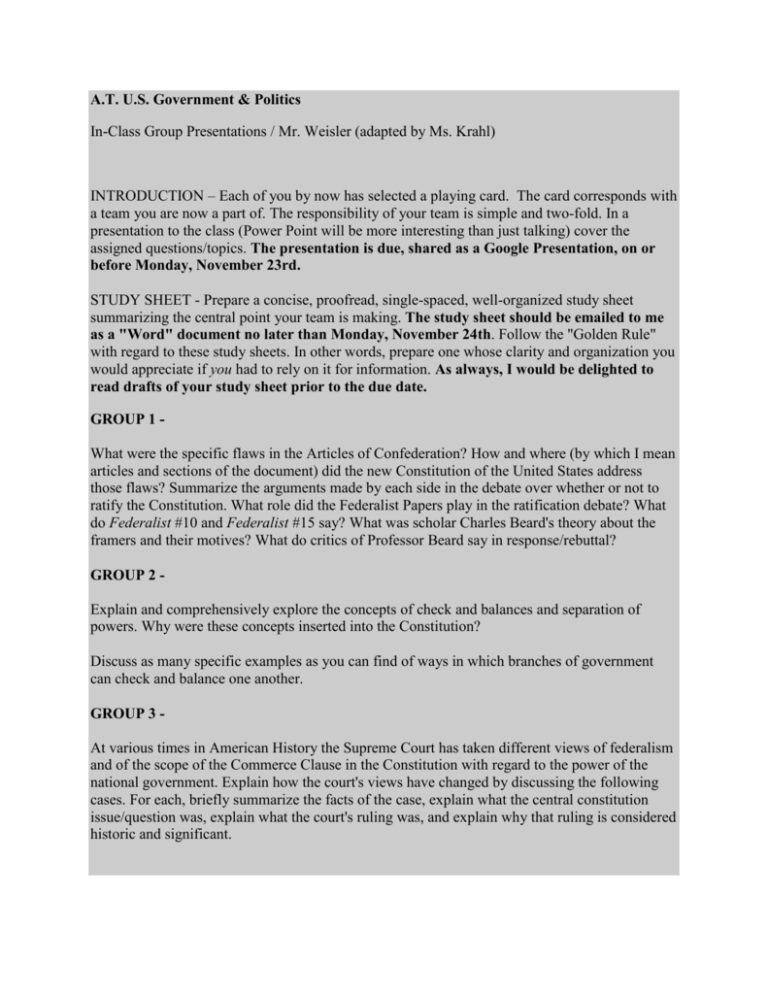
A.T. U.S. Government & Politics In-Class Group Presentations / Mr. Weisler (adapted by Ms. Krahl) INTRODUCTION – Each of you by now has selected a playing card. The card corresponds with a team you are now a part of. The responsibility of your team is simple and two-fold. In a presentation to the class (Power Point will be more interesting than just talking) cover the assigned questions/topics. The presentation is due, shared as a Google Presentation, on or before Monday, November 23rd. STUDY SHEET - Prepare a concise, proofread, single-spaced, well-organized study sheet summarizing the central point your team is making. The study sheet should be emailed to me as a "Word" document no later than Monday, November 24th. Follow the "Golden Rule" with regard to these study sheets. In other words, prepare one whose clarity and organization you would appreciate if you had to rely on it for information. As always, I would be delighted to read drafts of your study sheet prior to the due date. GROUP 1 What were the specific flaws in the Articles of Confederation? How and where (by which I mean articles and sections of the document) did the new Constitution of the United States address those flaws? Summarize the arguments made by each side in the debate over whether or not to ratify the Constitution. What role did the Federalist Papers play in the ratification debate? What do Federalist #10 and Federalist #15 say? What was scholar Charles Beard's theory about the framers and their motives? What do critics of Professor Beard say in response/rebuttal? GROUP 2 Explain and comprehensively explore the concepts of check and balances and separation of powers. Why were these concepts inserted into the Constitution? Discuss as many specific examples as you can find of ways in which branches of government can check and balance one another. GROUP 3 At various times in American History the Supreme Court has taken different views of federalism and of the scope of the Commerce Clause in the Constitution with regard to the power of the national government. Explain how the court's views have changed by discussing the following cases. For each, briefly summarize the facts of the case, explain what the central constitution issue/question was, explain what the court's ruling was, and explain why that ruling is considered historic and significant. McCulloch v. Maryland (1819), Gibbons v. Ogden (1824), United States v. E.C. Knight (1894), Hammer v. Dagenhart (1918), Schechter Poultry v. United States (1935), National Labor Relations Board v. Jones and Laughlin Steel (1937), West Coast Hotel Co. v. Parrish (1937), Wickard v. Filburn (1942), Heart of Atlanta Motel v. United States (1964), Katzenbach v. McClung (1964), United States v. Lopez (1995), National Federation of Independent Business v. Sebelius (2012). GROUP 4 Discuss the issue of federalism (i.e. relations between the national government and the states) beyond the courts. Define, explain, and discuss the following terms: devolution, unfunded mandate, dual federalism, grants-in-aid, categorical grants, block grants. In doing so, explain what each term has to do with the modern concept and practice of federalism. GROUP 5 Describe and explain the leadership structure of the United States Senate and the House of Representatives. Identify the key positions in each chamber, and on each side of the aisle within each chamber. Discuss the powers and responsibilities of positions like: Speaker of the House, President Pro Tempore of the Senate, and Senate/House Majority and Minority Leader. Explain what the whip system is and who the whips are. Finally, discuss the constitutional role played by the Vice-President of the United States in the activities of the United States Senate. GROUP 6 Guide us through the process by which a bill becomes a law, stopping at and explaining the major steps, rules, and potential obstacles along the way. Be sure to touch upon the following terms - sponsor/co-sponsor, standing committee, committee chair and ranking member, seniority system on committees, open rule/closed rule, filibuster, cloture, role of Vice-President, conference committee, conference report, veto, pocket veto, and override. GROUP 7 - Explain both the formal and informal powers of the President of the United States. Which type of power do you think is actually more useful or important? Outline both sides of that argument. From time-to-time the White House and Congress have found themselves in conflict over a variety of issues. Discuss the conflict – mentioning both sides – as it pertains to (a) War Powers (b) Impeachment (c) The Line-Item Veto (d) Impoundment (e) Independent Counsels During the 1970's, 80's and 90's. GROUP 8 Take us through the process by which the Supreme Court comes to consider and ultimately rule on a case, stopping at and explaining all the major steps and procedures along the way. Be sure to touch upon the following terms – original vs. appellate jurisdiction, judicial conference, amicus curiae brief, writ of certiorari, oral argument, the role of the solicitor general, majority, concurring, and dissenting opinions. Briefly summarize both sides of the debate - between “judicial activists” on the one side and advocates of “judicial restraint”, “strict constructionism” or “original intent” on the other – about what the proper role of federal judges should be. All students will read and take quizzes on the following chapters in your textbook: 2,3, 6, 7,8, and 9

